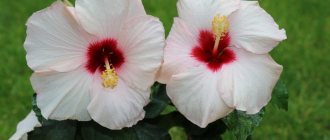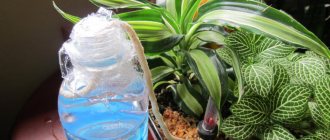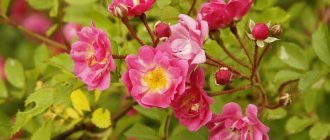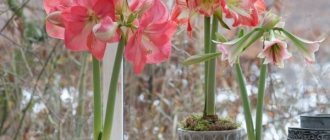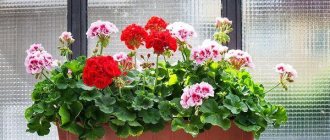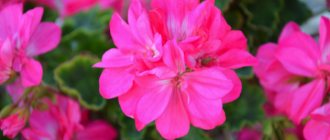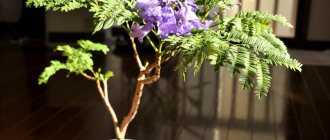Description of the plant
Cordilina is a representative of the Asparagus family. In nature, it is found in all regions with subtropical and tropical climates.
This is a tree or shrub with thick and strong roots and lanceolate, sword-shaped or linear leaf blades.
Attention! At home, cordyline grows extremely slowly.
The annual growth is 10-15 cm. In height, as a rule, the plant does not exceed 1.5 m. With age, the lower leaves of the shrub die and fall off, as a result of which the plant becomes similar to a palm tree. Flower growers value cordilina for its spectacular foliage and unpretentiousness.
Croton
Croton is another plant from the spurge family; many professional gardeners recognize it as one of the most attractive decorative foliage flowers. The main advantage can be called a worthy decoration of virtually any interior without the need to allocate significant space for it.
All the features of caring for croton are discussed below:
- The plant responds positively to bright light, but is very sensitive to an excess of sunlight, so in summer it is best placed on the north side, and in winter it is moved to the south. This will allow him to sunbathe exclusively in the morning and evening hours.
- The optimal temperature in summer is +20 – +22°C, and in winter at least +16°C.
- Watering must be done regularly so that the soil is always moist, but excess moisture must also be avoided, otherwise there is a risk of rotting of the root system.
- Ambient humidity is very important for croton; it grows poorly in rooms with dry air. To create the most comfortable conditions, it is recommended to spray daily from a spray bottle.
- Special requirements are imposed on the water that will be used for irrigation: it must be warm enough, it must first be subjected to a filtration procedure or settled, which will help get rid of a number of harmful impurities.
- In the summer, the croton needs a warm shower every month, but during this procedure it is necessary to ensure that water does not flow inside the pot, as this will lead to waterlogging of the soil.
- For fertilizing, a complex solution of various mineral fertilizers is used, which are applied only to pre-moistened soil. From mid-spring to late autumn, the procedure is carried out twice a month; in winter, it can be reduced to 1 feeding every month.
- As they grow, mature plants must be pruned so that they form a beautiful crown of the correct shape. All sections must be treated with sulfur powder or a charcoal mixture. This is necessary for faster healing of wounds and minimizing the risk of infection.
- Young plants are not pruned, but they must be pinched. You can start doing this from the moment the croton grows to 15 cm in height.
- If flowering does not represent any decorative value, then all young buds should be cut off in a timely manner, since this process takes a significant amount of energy from the croton.
How does it bloom?
Flowering of the plant occurs only in nature, at the age of 8-11 years.
When grown at home, it is almost impossible to admire the extraordinary flowers of this beauty. If this happens, it will be no more often than once every three years.
Cordyline blooms with small white, cream, red or purple flowers, collected in dense paniculate inflorescences reaching a length of up to 1 m.
The largest indoor plants
Indoor flowers are an oasis among the concrete jungle. They add originality, beauty and comfort to the interior. They purify the air, relieve stress and make the home more harmonious. And large plants boldly act as the main element of decor. Here are our favorites.
The shrub palm from the forests of Mexico and Guatemala is very popular among gardeners; there is nothing difficult in caring for it. Loves diffused light, but not necessarily sunlight, artificial light is sufficient. Tolerates shade calmly and can stand in the back of the room. In summer, the best room temperature for it is up to 27°C, and for wintering it is advisable to place it in the coldest place in the house (from 12 to 16°C). You need to water systematically and abundantly once the top layer of soil dries out. Loves moist air and spraying. And under no circumstances place it near heating.
Another palm tree, but with a single trunk. A large number of stems with pinnately dissected plates are formed in the upper part. It grows slowly, so it can delight you for years. Howea is unpretentious, small mistakes in care will not harm it, but for growth and splendor you will have to take care of the plant. It tolerates both sun and shade well, prefers warmth and humid air, but easily tolerates slight frosts (down to -5°C, it is advisable to insulate the roots). It likes regular, abundant watering and when the top layer of soil is slightly moist, but do not allow the liquid to stagnate. And in spring and summer, the palm tree should be fed a couple of times a month.
Varieties and species with names and photos
The plant unites about 20 different species, differing in size, shape and color of the leaf plate. The following are especially popular.
Straight variety
The most unpretentious look . It reaches a height of 3 m.
It has linear or lanceolate leaf blades with slightly serrated edges, colored green or purple. Leaf length is 60 cm, width - 3 cm. It is distinguished by a high, straight stem, covered below with the remains of dying leaves.
Feels comfortable in cool rooms.
Red
Palm lily or Cordyline rubra is a valuable ornamental plant. Can grow up to 4 m.
It has leathery, slightly concave, lanceolate leaves that are dark green with a reddish tint. Leaf length 50 cm, width 4.5 cm. Blooms in summer with lilac flowers. It does not require special care.
Apical
The most popular species for home cultivation. It has a straight thin trunk, which can sometimes be slightly branched. It reaches a height of 2 m.
It has green lanceolate leaf blades with a crimson, red, pale pink border or stripes.
When kept indoors, it remains compact for a long time and does not have a trunk.
Sheet length 50 cm, width 10 cm.
Fruticosis
A plant with one or several thin trunks up to 1.5 cm in diameter. The leaves are lanceolate, veined, 50 cm long and 10 cm wide.
The length of the petiole is 15 cm. In nature it has a green or variegated color with a purple tint. Blooms with loose cream panicles .
Mix
This is not the name given to a specific variety, but to species and varieties of Cordyline collected on one pallet under one name, denoting mixing.
Australis
Incredibly spectacular, yet undemanding, the plant is especially loved by gardeners.
It has rich green or striped narrow leaves up to 3 cm wide and compact attractive bushes. Outwardly it resembles a dracaena .
Mambo with scarlet or purple leaves
The plant has a thin trunk and an unusual color range of leaf blades, which can be rich green, scarlet, bright red, burgundy or purple. At home, the height does not exceed 1.5 m.
With proper care, it can delight you with gorgeous white or red-purple flowers.
Also called king tree.
Southern dracaena
The tallest type . In its natural environment it grows up to 12 m.
It has a rigid, widening trunk and sword-shaped leathery green leaves with a wide central vein of light color. It blooms with white flowers with a pleasant aroma, collected in meter-long panicle inflorescences. Sheet length 90 cm, width 7 cm.
Terminalis
It is distinguished by large lanceolate leaves of various shades: from soft pink and green to brown or burgundy. In nature it grows up to 3 m in height.
It has erect stems, which become bare in the lower part over time, while maintaining an attractive appearance.
Tango
A variety of cordyline apex.
They are small and neat trees with lush tufts of leaves of a non-trivial brown color with white veins and scarlet edging. Moreover, with age, the plant does not lose the splendor of the rosette and its beauty.
Names and descriptions of indoor flowers with red leaves at the top
The red leaves at the top of the flower look especially impressive.
Neoregelia
A popular houseplant with colorful leaves is Neoregelia. The flower got its name in honor of the botanist Regel. Externally, it is a tightly assembled rosette of thin leaves. The width is about 5 cm, the height is up to 30-40 cm.
Flower with red leaves
Important! The flower does not always have a constant color. During the dormant period, the core of the rosette is green. Before flowering, the middle of the flower acquires a bright color: from scarlet to pink.
Neorgelia is an epiphytic flower and under natural conditions can grow on different surfaces: both in the soil and on a tree trunk. Therefore, homemade nonorgelias are often grown using the hydroponics method, that is, in a water composition without planting in the soil.
Neoregelia
Poinsettia
An indoor flower with red leaves at the top is poinsettia. Scarlet leaves form a kind of bright “flower” that frames the inflorescence. The edge of the sheet may be bordered by a beige or white thin stripe. Active vegetation occurs during the cold season, flowering occurs at the beginning of January, which is why this plant is also called the “Christmas star.”
The plant is a little picky when it comes to care. Poinsettia loves light, but does not tolerate direct sunlight, because there is a high risk of burns. For normal growing season, the air temperature in the room should be at least 16-17 °C, watering should be moderate.
Poinsettia
Guzmania
Guzmania has a brightly colored inflorescence - the part that frames the inflorescence. The inflorescence is at least 5 cm long. The dense leaves of guzmania form a neat rosette. The color of the leaves below is bright green. The top of the plant (inflorescence) is brightly colored. The inflorescence can be red, yellow, or orange. The flowers themselves are light and inconspicuous. Flowering lasts up to 3 months.
Note! The root system of guzmania is poorly developed, so it is better not to add hard substrate and stones to the soil.
Guzmania also requires periodic feeding with mineral fertilizers.
Guzmania
Benefits, harms and properties
According to superstitions, cordilina has a positive effect on creativity and, being a true peacemaker, maintains a warm atmosphere in the house, helps restore the aura, neutralizes quarrels and suppresses gossip.
It is recommended to keep Cordilina in houses where strangers often come : thanks to her, the owners will never feel tired and empty after the guests leave.
In the teachings of Feng Shui, cordilina combines the energy of wood and fire. By placing it in the corner of the room, you can activate the Chi energy. In addition, the plant belongs to the Yang type and is not recommended for placement near working and sleeping places. The optimal part of the house for cordilina is the south or east side.
Pruning a domestic palm tree
Removing weak and diseased shoots contributes to the rejuvenation and formation of the plant . Thanks to pruning, the lateral buds begin to grow, and the cordyline creates a dense leafy crown.
You should take a sharp and clean knife and trim the top of the bush. It is important that the cut part is no shorter than 6 cm, has leaves and is woody. Then the cut areas must be sprinkled with coal powder. After 14-20 days, fresh shoots will appear at the cutting sites.
The cut top can be rooted in water or a damp mixture of peat and sand, and after the roots appear, plant it in a small pot.
Fruit houseplants, their photos and names
There are indoor indoor plants that will not only decorate your living space with their appearance, but will also bear edible fruits. Here are the names and photos of some fruit-bearing indoor plants: lemons, tangerines, kiwi, figs, pineapple, mini peppers and even pomegranate.
Indoor lemon
It differs from its relatives in dwarf varieties that bear fruit in apartment conditions and bear up to 20 lemons. Indoor lemon smells very strongly, corresponding to its name, and is very decorative, because it does not have a dormant period, and on the tree you can always see green glossy foliage and flowers, and lemons.
The plant needs additional lighting and warmth, but it is better to cover heating devices, if they are nearby.
Indoor lemon
Figs
In the house it begins to bear fruit in the first year. They care for figs just like lemons, but remember that the tree sheds its leaves at the end of October. A rest period is required; it is tedious to move the figs to a cool place and shade them with a dark cloth. It is good to lower the tree into the basement and water it as little as possible. After a while, the plant will begin to develop new buds, which means it’s time to return the figs to the bright windowsill.
Figs
We covered a very small part of the catalog of indoor plants, but we hope that our article turned out to be informative and educationally useful.
Propagation by seeds
Help : with the seed propagation method, the varietal characteristics of the parent plants are lost, so it is suitable only for species plants.
Seeds are sown in early March in turf soil mixed with sand. They sprout unevenly and germinate for quite a long time, within 1-3 months, but the grown trees are fully adapted to home conditions.
Now you have the necessary information about this chic and unpretentious plant that can decorate your home or office and create a peaceful atmosphere in it. All that remains is to choose the type of cordyline that is most attractive to you.
